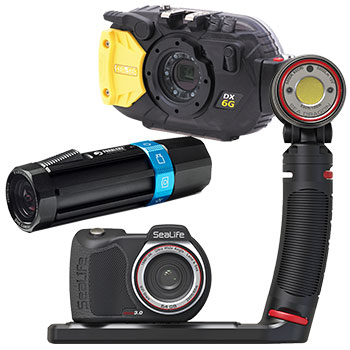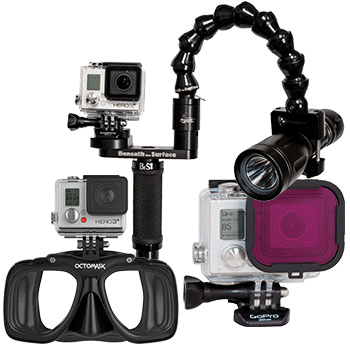Photography
Learn MorePhotography
Understanding Scuba Dive Cameras
When we venture underwater with scuba dive cameras, it's essential to have the right equipment to capture the beauty of the deep. Let's explore the types of cameras available and the features that make for superior underwater images.
Types of Scuba Dive Cameras
Action Cameras: These are compact, durable, and typically offer wide-angle lenses. Perfect for scuba diving, action cameras like the GoPro are favored for their size and ease of use.
Compact Cameras: Generally user-friendly, these cameras are a budget-friendly option for entry-level underwater photographers. Many models now come with underwater modes to optimize shooting conditions below the surface.
 Cameras
Cameras Camera cases
Camera cases Camera Accessories
Camera Accessories GoPro AccessoriesLoading...
GoPro AccessoriesLoading...Mirrorless Cameras: A step up, mirrorless cameras provide better image quality and offer a balance between the portability of compact cameras and the performance of DSLRs.
DSLR Cameras: For professional-quality images, we turn to DSLR cameras. They offer the highest image quality and versatility but require an underwater housing to protect them from the water.
Underwater Housings: Essential for protecting non-waterproof cameras, housings must match the camera model and allow access to necessary controls.
Read moreKey Features for Quality Underwater Photography
Resolution: High megapixel count ensures that the images we capture are clear and detailed, which is crucial for photographing the complex textures of marine life.
Manual Controls: Being able to manually adjust settings like exposure, aperture, and shutter speed allows for greater creativity and adaptability to varying underwater conditions.
White Balance: Accurate white balance adjustment is key to reproducing natural colors that are often lost beneath the water.
Lens & Port Options: Wide-angle and macro lenses are particularly useful for scuba diving photography, capturing sweeping seascapes or close-up details of marine organisms.
Depth Rating: The camera or housing should have a depth rating suitable for your diving activities, ensuring it can withstand the pressures encountered at your intended dive depth.
Selecting the Right Camera for Scuba Diving
When choosing a camera for scuba diving, it's crucial to consider the camera's underwater performance capabilities and how they match with the diver's experience level.
Camera Specifications and Performance
First and foremost, the camera's housing is essential for underwater protection. The housing must be waterproof and rated for a depth that exceeds the diver's typical diving range. Durability is also a key factor, as the camera will face various pressures and conditions. When assessing video and photo quality, we look for cameras that offer 4K video and high-resolution photos, ensuring top-notch image quality.
For optimal videography and still photography beneath the waves, we prioritize cameras with excellent low light performance and manual white balance control to manage the different lighting environments. A camera like the GoPro Hero10 or Olympus TG-7 with built-in image stabilization helps in capturing steady footage amidst the underwater current. Good autofocus is critical for moving subjects, and shooting modes tailored for underwater such as macro mode enable us to capture the beauty of marine life.
When looking at camera brands on the market, some reputable ones include GoPro, Olympus, SeaLife, and Canon. Cameras like the SeaLife Micro 3.0 and SeaLife SportDiver are designed specifically for underwater use and come with enhanced seals and shockproof ratings for extra safety. Lighting is another factor where external flashes and video lights can dramatically improve underwater photography. It is also integral to check reviews for user experiences regarding a camera’s ease of use under water.
To facilitate operations like adjusting exposure, zoom capabilities, and various manual controls, we ensure that the size and weight of the camera affirm comfortable handling. Other features such as GPS, raw support, and white balancing assist in enhancing the image quality and maintaining natural colors. Lastly, the camera's battery life must be sufficient to last through our dives to avoid the frustration of a dead camera in the middle of an underwater adventure.
Considerations for Different Skill Levels
For novices, ease of use is paramount and cameras such as the Nikon W300 or Akaso EK7000 are straightforward and budget-friendly. They offer automatic shooting modes and stabilization making them suitable for those starting out with underwater photography or simply engaging in snorkeling.
Intermediate divers may prefer advanced point-and-shoot cameras such as the Sony RX100 VII or Panasonic Lumix LX10, which provide greater control over manual settings while remaining relatively easy to handle. Their better sensors and wider range of lens selection enable sharper still shots and wide-angle underwater video.
Experienced divers and professionals should look towards higher-end models like the Canon PowerShot G7X III or Sony Alpha A6600, allowing for interchangeable lenses and advanced manual controls to tailor every aspect of the underwater shooting experience. These models typically offer higher megapixels, substantial raw support, and underwater color correction features, suited for capturing detailed images of small critters and expansive wide-angle scenes.
Regardless of skill level, it's essential to balance performance features with budget and price range. Additionally, accessories such as a tray, buoyancy control devices, and underwater flashes can enhance the scuba camera experience by improving handling, lighting, and overall underwater photography tips. Always consult a current buying guide and comprehensive reviews to make an informed decision tailored to our specific needs as underwater photographers.
Enhancing Your Underwater Photography
To capture the majesty of the underwater world, we must equip ourselves with the right gear and hone our skills. Let's explore how accessories and lighting can vastly improve our underwater photography, and delve into advanced techniques for photographing marine life effectively.
Accessories and Lighting
For top-notch underwater photography, selecting the right accessories is imperative. Our camera should ideally be housed in a sturdy waterproof case specifically designed for the model. For example, the Olympus TG7 thrives underwater when secured in its corresponding case, maintaining its full zoom capabilities and macro mode. Adequate lighting is also crucial; underwater environments tend to be dim, and colors can appear washed out. Here, flashes and additional light sources can make a significant difference.
By introducing external light, we enhance our ability to capture vibrant still images and improve video quality. It's essential to position our lights strategically to avoid backscatter—a phenomenon where particles in the water reflect light into the camera sensor, causing undesirable spots in our photographs.
Essential Lighting Gear
Accessory Function Strobe Illuminates subjects for clearer still photography Video Light Provides continuous lighting for video Focus Light Aids in low light conditions for sharper focus Advanced Techniques for Capturing Marine Life
Our approach to photographing marine life should include both technical know-how and an understanding of aquatic behavior. Mastering manual white balance is one of the key techniques. It allows us to correct color distortions caused by water depth and composition, which tend to shift the color towards blue or green, obscuring true hues. High-quality underwater cameras like certain DSLR models come with the option to adjust manual white balance, preserving the natural colors of the underwater scenery.
Capturing marine life also involves patience and a keen eye. Rather than chasing subjects, we should learn their habitats and behaviors to anticipate their movements. Still photography benefits from techniques like slow shutter speeds to convey movement or fast shutter speeds to freeze a moment with clarity. When shooting video, employ a video camera with continuous focus ability to maintain sharpness even as subjects move.
Advanced Capture Techniques
- Manual White Balance Adjustment
- Slow/Fast Shutter Speed Utilization
- Behavioral Anticipation and Positioning
Here For YouWe know looking at Scuba Gear can be challenging.
Real Dive Shop, Real Divers, Real Answers!
Click here to email us so we can help you find the best options. Want to talk to a live person? No worries!
Call us at 815 267 8400 or hit us up on live chat!They SayOur ServicesDRIS EventsCopyright © Dive Right in Scuba.All Rights Reserved.

